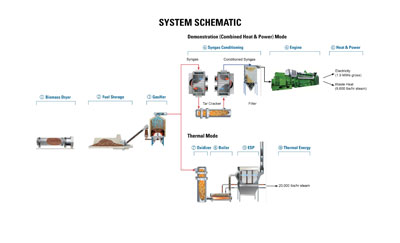
Cleaning Up
November 29, 2012
By
John Tenpenny
Effectively developing a next-generation clean tech system requires just the right combination of circumstances, and proving that the technology works is just the first step.
Effectively developing a next-generation clean tech system requires just the right combination of circumstances, and proving that the technology works is just the first step.
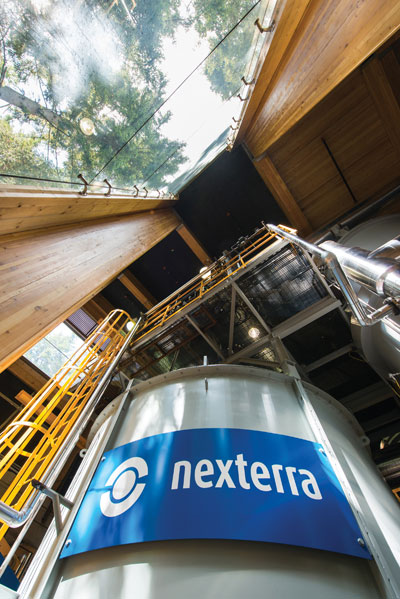 |
|
| Nexterra’s gasification system converts wood residue into syngas.
|
The tougher challenge is commercialization and that means finding partners willing to risk significant amounts of capital and convincing them of the benefits of the project.
The perfect storm seems to have gathered on the UBC campus in Vancouver, where the university has partnered with Nexterra Systems, GE and others to launch an energy-from-renewable-waste combined heat and power (CHP) system. The project combines Nexterra’s first commercial demonstration of gasification and syngas conditioning technology with GE’s high-efficient Jenbacher internal combustion engine (IC) to generate electricity.
Officially named the Bioenergy Research and Demonstration Facility (BRDF), the $34-million project is the first development to produce economic, community-scale heat and power using an IC engine fuelled by biomass. Langley-based Cloverdale Fuels delivers two to three truckloads daily of locally sourced biomass, consisting of tree trimmings and wood chips diverted from local landfills.
Combined Heat and power
The CHP system has two main operating modes. The first, “thermal-only mode,” uses commercially proven gasification technology developed by Nexterra to turn biomass into a clean synthesis gas, or “syngas.” The syngas replaces natural gas used to produce steam and hot water to meet campus heating needs.
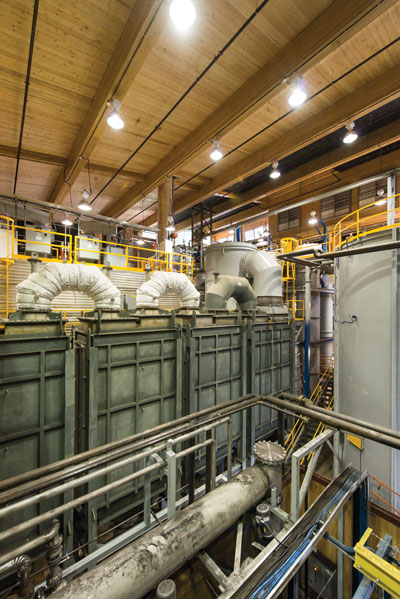 |
|
| Nexterra’s syngas thermal cracking/conditioning system feeds the GE internal combustion (IC) engine
|
In the second, “demonstration mode,” the syngas is conditioned to remove impurities such as tar that would normally “foul” the internal combustion engine, then cooled, filtered and injected into the GE Jenbacher gas engine that drives the generator to produce electricity. Additionally, heat from the engine is recovered and directed to the district heating system. The system will deliver global electrical efficiencies that are 25% higher than traditional methods of producing biomass-based electricity at this scale.
The thermal system can handle biomass moisture content above 50%, whereas the demonstration system requires the biomass to be dried until the moisture content reaches 25% or less. It takes a particle of feedstock approximately an hour to transit the system.
The electricity produced will feed into UBC’s power grid, which will result in revenue to UBC through a “displaced load agreement” with BC Hydro. UBC is BC Hydro’s second largest customer.
GE’s Jenbacher gas engine will produce 2 MW (megawatts) of clean, renewable electricity that will offset UBC’s existing power consumption, enough to power approximately 1,500 homes. The engine system will also generate 3 MW of thermal energy, enough steam to displace up to 12% of UBC’s natural gas consumption. In thermal mode, the system can produe 7 MW of heat. This will reduce UBC’s greenhouse gas emissions by up to 5,000 tonnes per year, which is the equivalent of taking more than 1,000 cars off the road.
“This exciting facility targets a major challenge facing society – the need for new, clean energy solutions that work at a community scale,” said UBC president Stephen Toope. “This is a flagship example of UBC as a living laboratory, where researchers, staff, students and partners collaborate on innovations targeting the pressing challenges of our day.”
The startup of the system represents the culmination of more than four years of product development work and collaboration with GE’s Gas Engines business. Prior to installing the gas engine at UBC, Nexterra successfully completed more than 5,000 hours of trials at its Product Development Center in Kamloops.
The project is also noteworthy for its use of wood. The four-storey, 1,900-square-metre facility, conceived by FPInnovations as a pilot demonstration project, is also the first North American commercial application of cross-laminated timber (CLT), a new solid wood building material that can be used as a low-carbon, renewable alternative to steel frame construction. Designed by McFarland Marceau Architects, 410 cubic metres of CLT panels were used for all load bearing walls and most non-load bearing partitions, suspended floor and roof decks.
Startup
Since its founding in 2003, Nexterra’s focus had been perfecting a core gasification technology that would take waste feedstocks and reliably convert them into syngas, says president and CEO Mike Scott.
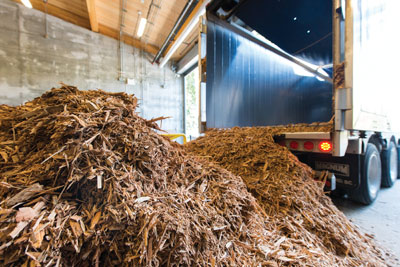 |
|
| Cloverdale Fuels of Langley drops off two or three truckloads of waste wood each day at UBC’s Bioenergy Research and Demonstration Facility (BRDF) |
|
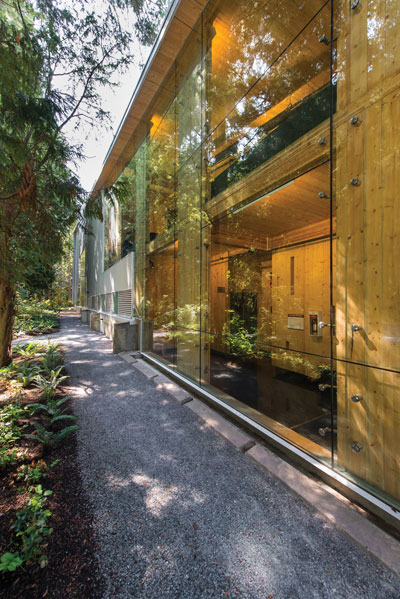 |
|
| The four-storey BRDF building was constructed using cross-laminated timber (CLT). |
“The idea was to compete against conventional biomass waste combustion systems and be cleaner and more efficient, with lower operating costs,” he says.
Its first commercial plant was commissioned in May of 2006 at a Tolko plywood mill near Kamloops that produces 38 million BTUs per hour. Since then, Nexterra has delivered six commercial plants in North America.
Shortly after, GE Jenbacher approached Nexterra after looking for a biomass gasification system to feed its engines, and not having much success.
“That’s when we started looking into a gas clean-up technology,” says Scott. “We had to find a way to get the tar out of the gas in a cost-effective and reliable way, and since we couldn’t find a system that worked, we thought we’d be better off developing our own proprietary system.”
After beginning testing, the company signed an MOU (memorandum of understanding) with UBC in 2009. Then the real work began.
UBC wanted to be an early adopter as well as support global companies in the power generation business, and according to Brent Sauder of UBC’s Sustainability Initiative, partners had to be found in order to get the rest of the project off the ground.
“UBC has its investment based on the performance of the thermal system,” he says. “We then de-risked the rest of the project by getting really good support from the various levels of government.”
Supporting the BRDF at the federal level were Natural Resources Canada and Western Economic Diversification Canada, while at the provincial level, the BC Innovative Clean Energy Fund and the Ministry of Forests, Mines and Lands got involved. Sustainable Development Technologies Canada, the BC Bioenergy Network, the Canadian Wood Council and FP Innovations were also enlisted.
“Something like this does not happen by one company going it alone,” says Scott. “It really does take a village.”
The village included the university community, not just students and faculty, but residents who live in the area.
“Building bridges with the community allowed us to raise their comfort level,” says Sauder. “And knowing Nexterra had a track record on emissions gave us the confidence that we were going to meet or exceed the city’s air shed requirements.”
A 24-hour air monitoring station on the site backs up his claim. “There’s no way you can tell if the plant is running or not by looking at the data.”
Scott says the company is excited about taking its gas cleanup and thermal cracking technology global and sees potential in international markets where power prices are relatively high, where there are renewable energy incentives and where there is built-in preference for distributed energy.
“We’re seeing interest in the U.K., Korea and Japan,” he explains. “Places that are ‘energy-stranded’ and have to import liquid natural gas.”
Although low natural gas prices in North America have had a chilling effect on renewable energy, Scott believes Nexterra may yet get an opportunity to replicate the system closer to home.
“There is a reasonable chance that over the next three to five years, a lot of natural gas in North America is going to be shipped offshore and we may see prices rise to world levels.”
Combined Heat and Power (CHP) System Operating Modes Demonstration (CHP) Mode
Thermal Mode
|
Print this page
